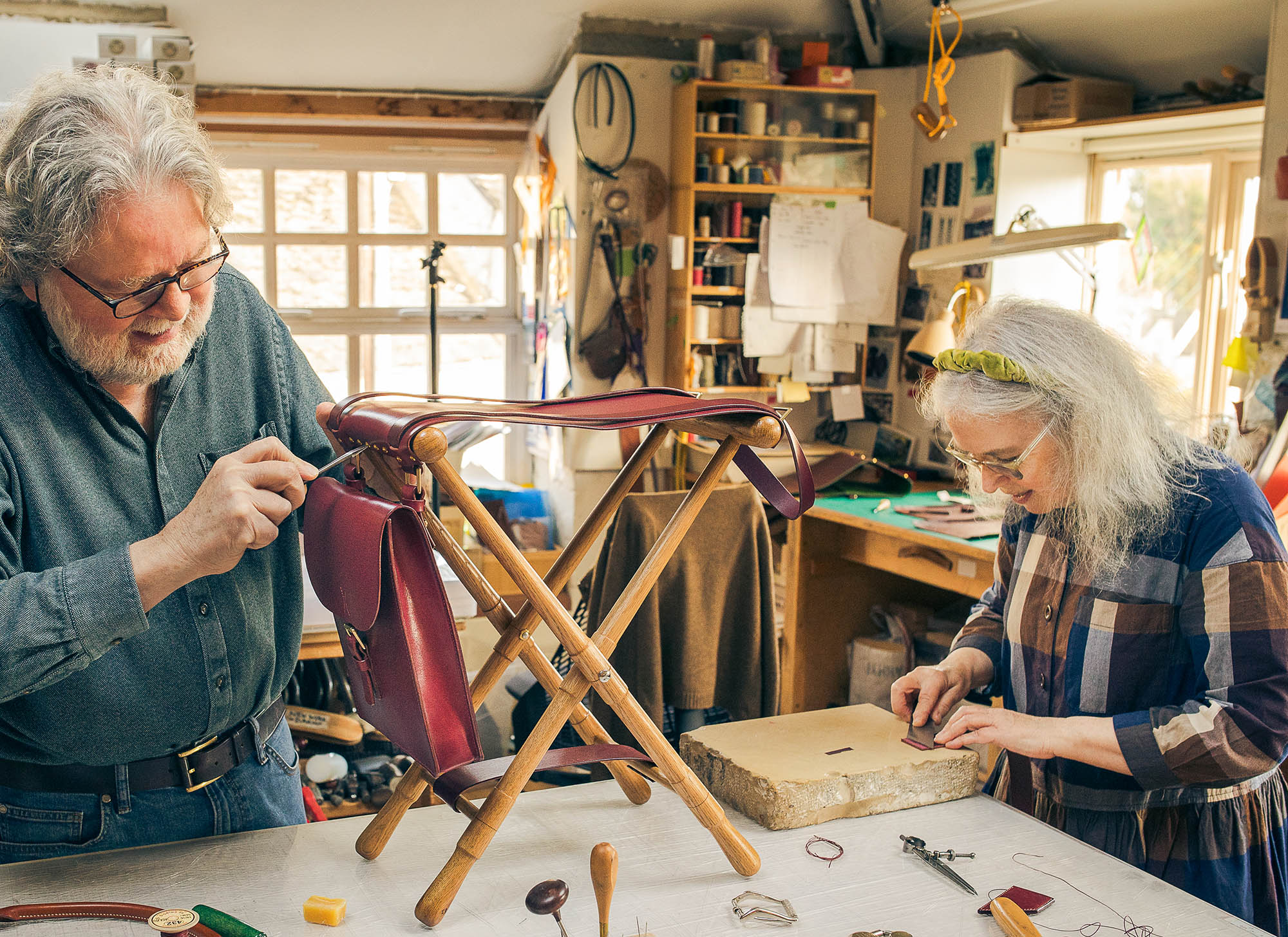
Words by Lucie Muir
Photography by Paul Read, Jenny Catlow, and Onur Pinar
A beautiful handcrafted accessory made from the finest leather, be that a tote bag or a pair of bespoke brogues, requires a trained hand and a breadth of knowledge that only experience brings. Thankfully, here in the UK, there is a dedicated group of makers willing to pass on the skills they have honed over the years to whole new swathes of budding leathergoods makers via workshops and private lessons. Without the generosity and passion of these inspirational teachers, the art of learning how to stitch a handle or build a shoe from scratch would be lost forever.
Mention the names Valerie Michael and Neil MacGregor in certain circles and inevitably, you will be met with a spontaneous smile and a story or two about how this legendary pair of leatherworkers are the reason for their pathway into the leather business in the first place.
From their Tetbury home-cum-workshop, Valerie and Neil have been teaching leathergoods making to thousands of students from all walks of life for the past thirty years, many of whom have gone on to start their own brands or teach the skills they have learnt here, to others around the globe. Valerie is also the author of the industry bible, The Leatherworking Handbook, still in print today, which she typed on an old Amstrad computer that was purchased with her advance, back in 1993. She then taught specific skills from the book at West Dean College, which in turn, led to students approaching her directly for private lessons.
Valerie and Neil’s story began in the summer of 1969 when the teenagers started dating before dabbling with the art of leather craft. “Basically, we were a pair of hippies back then with a lot of confidence and self-belief that only youth brings,” says Valerie. “We tried all sorts of different jobs and started playing around with different crafts, making all sorts of things. But there was a leather producer near us in Bristol so I knocked on the door, bought some leather and began designing some very simple bags, even though I knew nothing about making bags.
The young upstarts then got a shop share in the centre of Bristol. They turned the first floor into a workshop where they would create leather bags on the spot and sell them straight on the shop floor alongside clothes designed by Val’s brother. Says Neil: “We would often take the train to London, to visit the boutiques on the King’s Road, where we thought, well, we can easily do that, or, why don’t we try making this?” which they would promptly do on their return
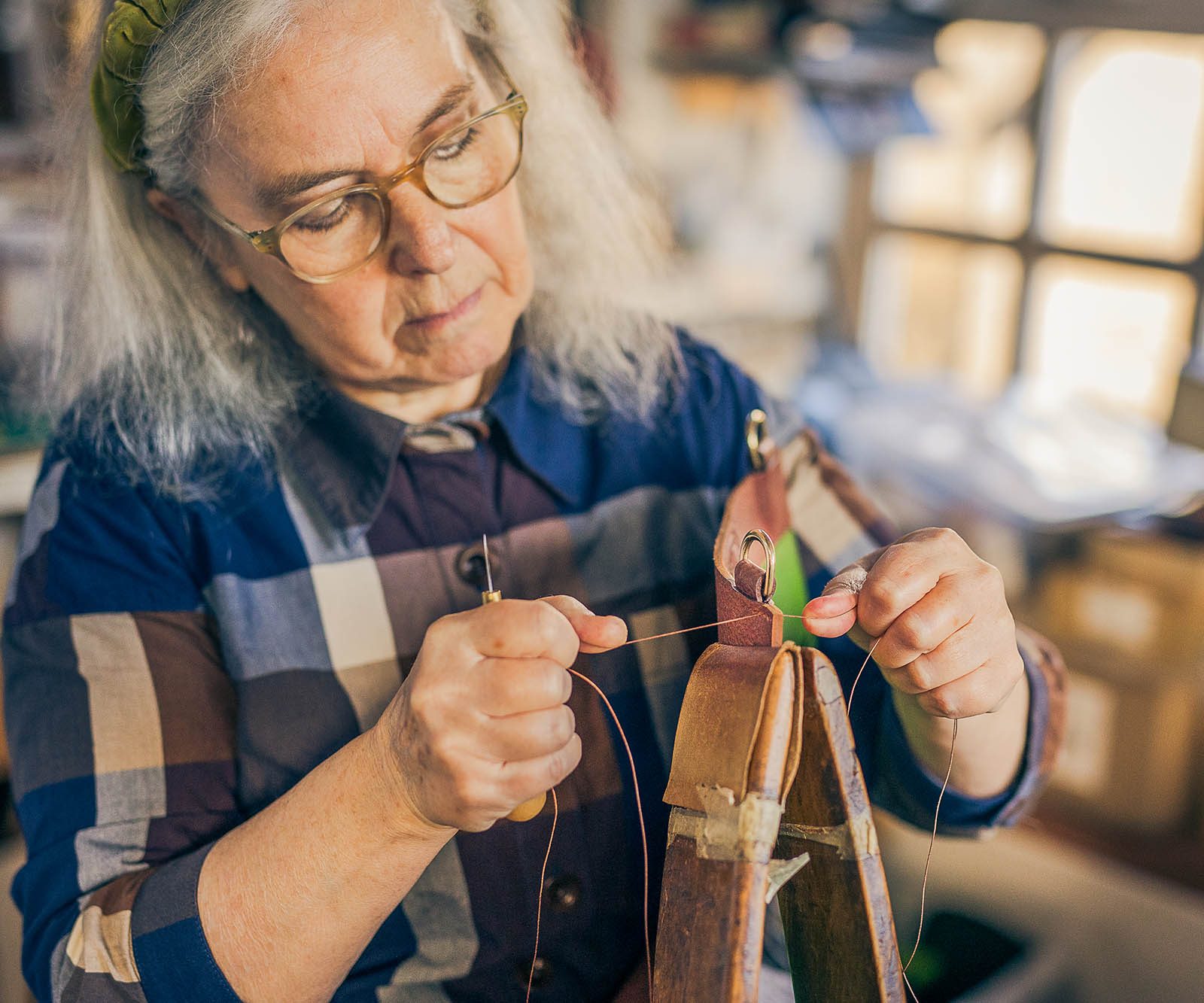
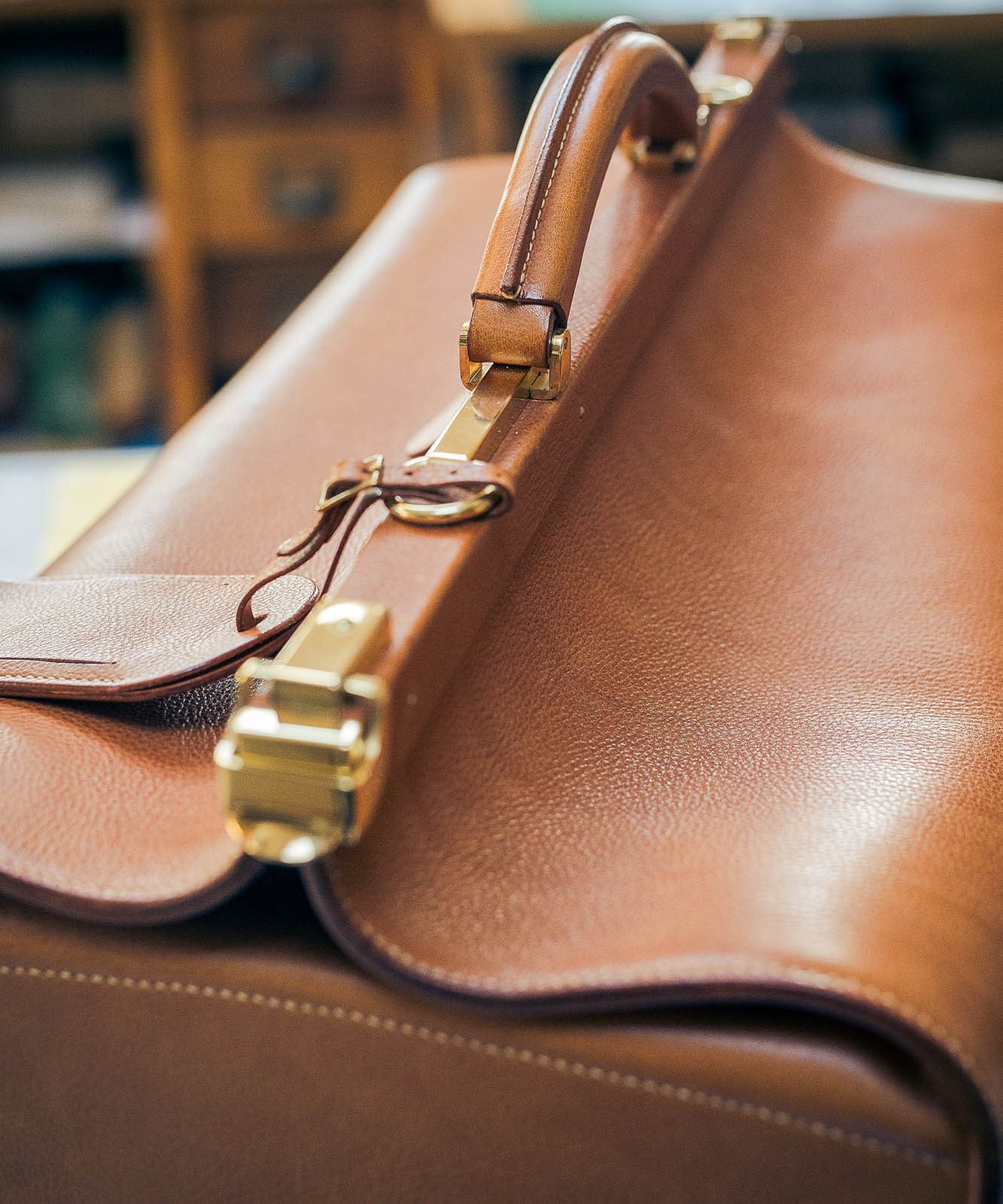
A quest for knowledge then led them to the Museum of Leathercraft in Northampton, where they were given unique access to the museum archives, studying fragile pieces of leather from the 17th and 18th centuries as well as the quilting and moulding that went into one of Queen Victoria’s saddles. All of which, says Val, “turned us on to even more possibilities of working with leather.”
Later, the makers upped sticks to the quaint Cotswolds town of Tetbury. Notes Valerie: “We quickly knew that we wanted to improve on our stitching and other leather techniques so I showed up at David Barnes’ workshop, the local saddler, and after he had stopped laughing at my terrible samples, he sat me down and showed me how to stitch properly. He also gave other invaluable tips about the sequence and rhythm of stitching. After that, we were off!”
Today, the pair make pieces to commission for furniture maker, Mathew Burt and gunmakers, Holland & Holland and James Purdy & Sons. Their own-label pieces – beautiful briefcases and bags made from vegetable-tanned leathers supplied by the same British tannery, J&FJ Baker, since 1974 – are sold through the Gloucestershire Guild Shop in Cheltenham. And then there’s the exquisite bespoke trunk Neil crafted from a roll of 200-year-old Russian leather that divers salvaged from a shipwreck, but that’s a whole other story.
Valerie and Neil’s leatherworking courses include taster weekends, six-day courses and spring and summer schools for anyone who has never picked up a leatherworking tool before. Here, specialist techniques including leather decoration are all covered. They also run classes on how to make a traditional English briefcase and men’s leather goods for those who have completed a course with them before.
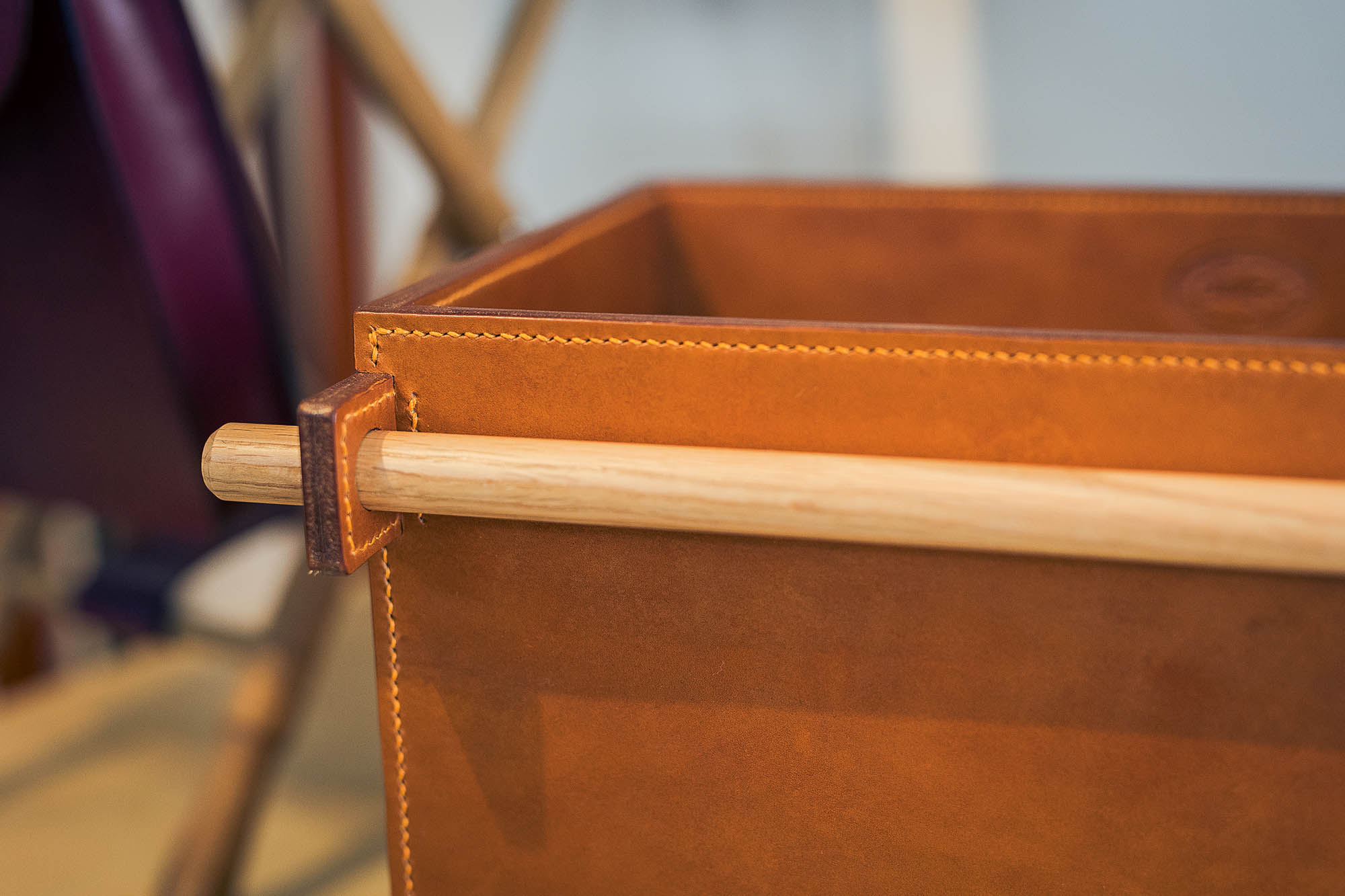
“All novices want to leave with a finished piece but I always say to them, ‘it’s not about necessarily finishing something but it’s the skills you are taking away with you that count,'” says Valerie. That said, Valerie is also strict when she needs to be. “When I’m teaching students the basic techniques, I don’t take any prisoners really. I am very particular about how they do the hand stitching – there is a sequence which if you follow, will get you good results – so I say to them ‘Leave here and go away you can do it however you want but while you are here you have to follow my way because I know you will get good results.”
And as Neil notes, teaching is all about giving. “We never hold any helpful industry information back from our students. Why would we?” Indeed, all students are provided with a list of tried and tested suppliers and can even tag an order onto one of Valerie’s and Neil’s, at no extra cost.
Says Valerie: “Knowledge is not an intellectual thing. Knowledge is the whole of us. There’s knowledge in our hands and in our experience and this is what we are passing onto others in a continuous loop. We learnt how to stitch from the local saddle maker, who learnt from his father who learnt from his father, so we are both the result of all those people. We take knowledge, make it our own and grow it. It’s almost a genetic thing.”
Yusuf Osman, is among the duo’s glittering alumni. Today, the maker, and now teacher, has his own leather brand and also hosts workshops in a space at London’s Cockpit Studios for aspiring leathermakers. Before attending his first leatherworking course with Valerie and Neil in November 2014, he was on track to be a lawyer, having moved from Leicester to enrol at the London School of Economics.
“Leatherworking was not an accessible craft when I started almost a decade ago and teaching was not readily available,” says Yusuf. “Like so many, I had purchased Valerie’s book, but it was years later and only after I qualified as a solicitor that I enquired about attending a course. It was my luck that a spot was available due to a cancellation. It was a weekend course in Tetbury that was my first introduction to working with leather.”
Indeed, some ten years on, Yusuf remains more committed and passionate about leather and craftsmanship than ever. His one-day private classes and online or business coaching and training bundles are tailored to suit all levels. In his Leatherworking with a Master Craftsman workshops to a maximum of four students, he gives an overview of the history of leather use and tanning along with modern methods and innovations in the leather industry. He also highlights the importance of craft as a defining feature of human civilisation and the importance of putting craft back into all aspects of our lives as individuals and as a society.
“I did not envisage teaching the craft, but I started in 2018 because of enquiries from eager students due to the lack of teaching available – initially on a one-to-one basis and later at a secondary school. When I started as a full-time leather craftsman a year later, I started with regular workshops in my studio that were an instant hit. Within a few months, I was teaching students from all over the world, including John Malkovich and other celebrities. Over the years I have taught many hundreds of students and now I also regularly travel abroad to give talks on leather and craftsmanship and to pass on my skills to passionate students everywhere!”
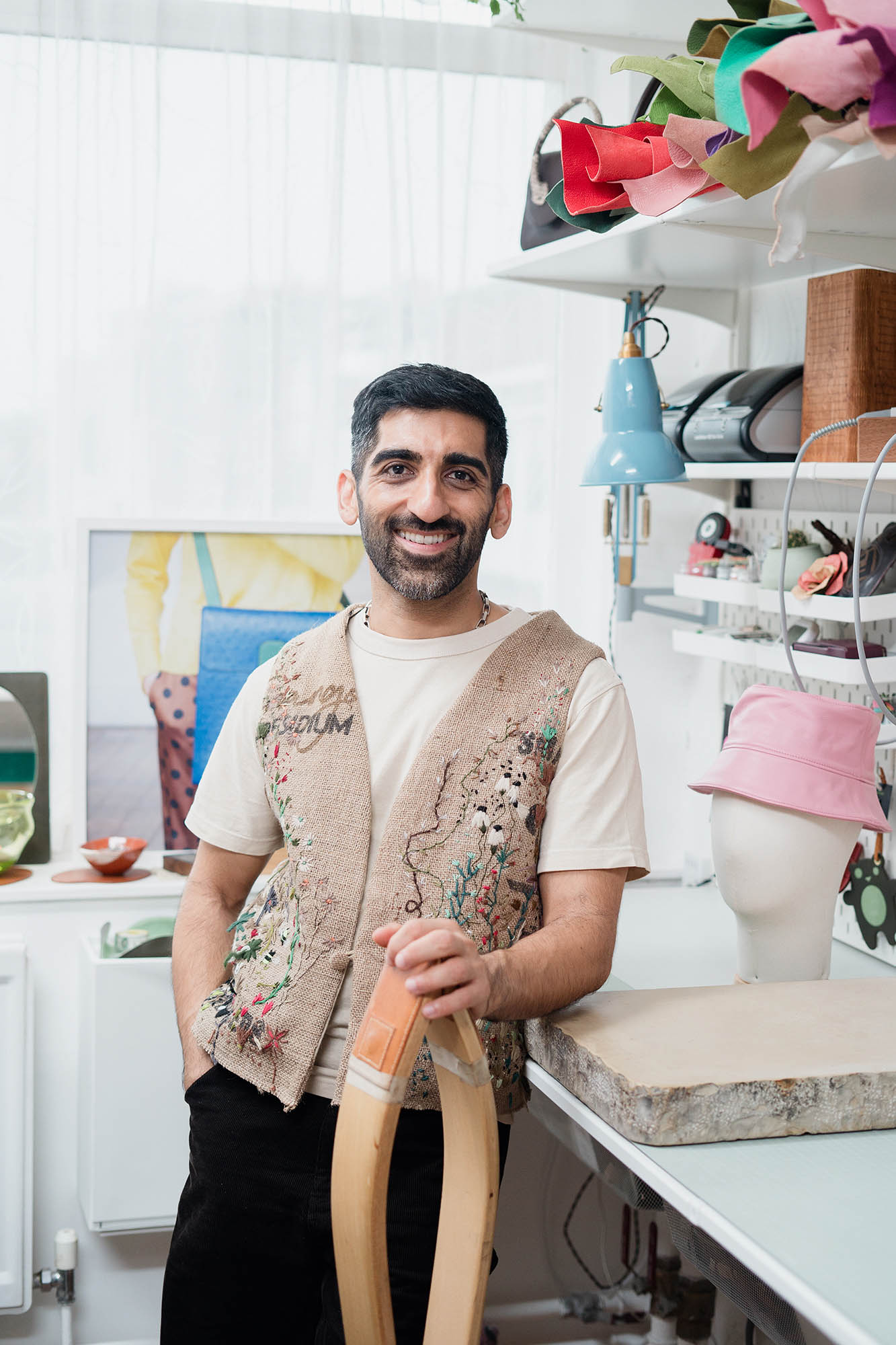
“One of the hardest things to teach is that you have to make mistakes to learn.”
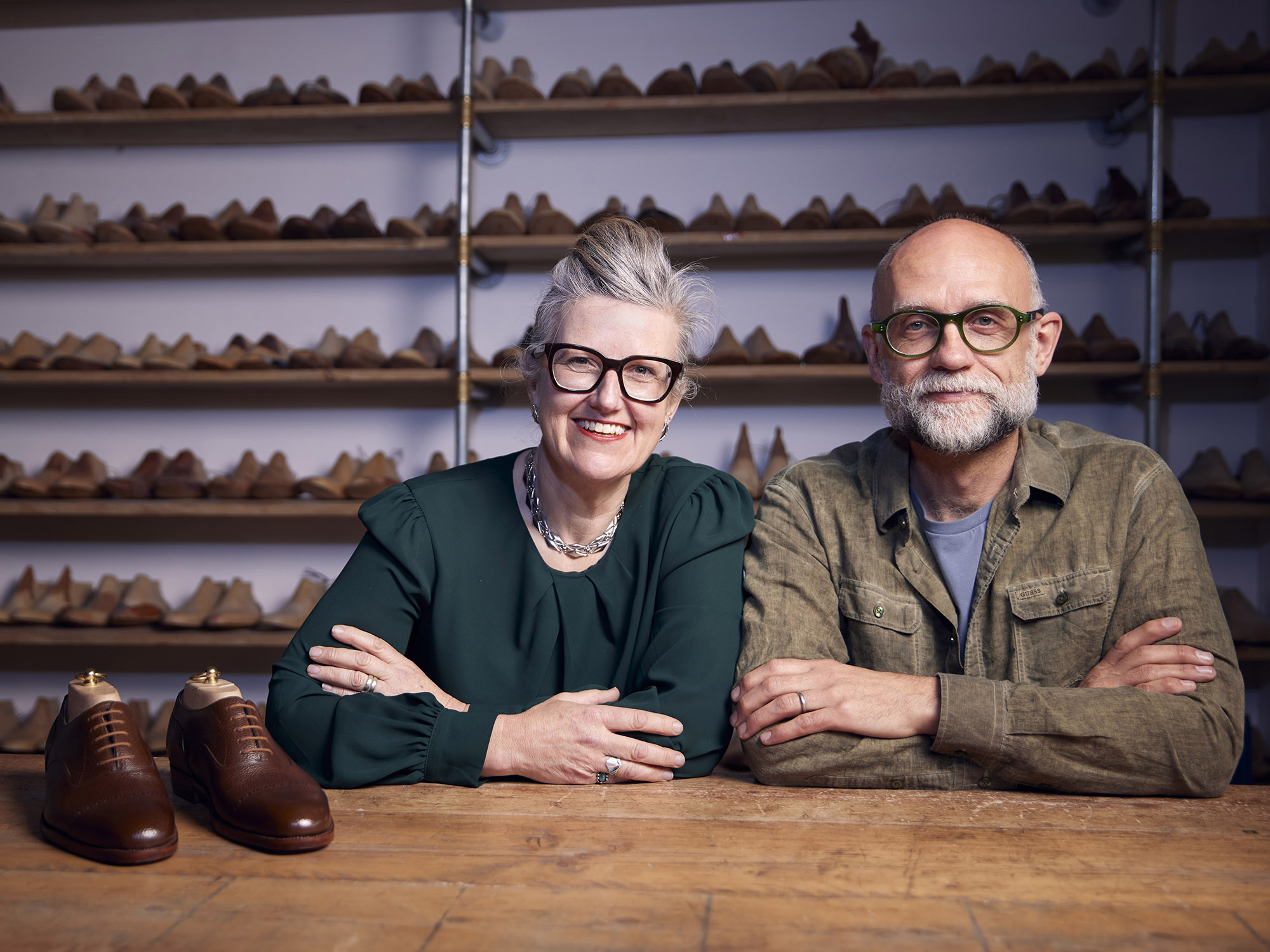
Elsewhere, maverick teaching duo and bespoke shoemakers, James Ducker and Deborah Carré, aka Carréducker, have played a pivotal role for over twenty years in educating those seeking to learn how to make a pair of shoes entirely by hand. The pair met when James was doing an apprenticeship with John Lobb and Deborah was a Queen Elizabeth Scholarship Trust, QEST, scholar, both training under master shoemaker, Paul Wilson.
“Paul was making for some of the biggest names in handsewn bespoke shoes at the time, so we were very lucky to train with him,” recalls James. “To have someone who was generous enough to share their skills was wonderful. He was a really enthusiastic teacher and also very patient and he made learning enjoyable.”
James who went on to teach the handsewn shoemaking course at Cordwainers College in Hackney, then later when it was taken over by the London College of Fashion at its Golden Lane premises spotted a gap in the market for teaching the intricacies of bespoke shoemaking once the LCF course ended in 2006. “We thought if no one else is doing it, we really should. Without new shoemakers coming into the trade, the craft risked becoming endangered or worse, disappearing completely.”
Deborah takes it from here. “At that point, it was nigh on impossible to see the craft in action, let alone try your hand at it. Entry into the trade was only through apprenticeship and since it’s such a niche trade anyway, opportunities were limited. When we started teaching our 12-day intensive course, we were frowned upon by some members of the industry for demystifying the process and effectively “giving our skills away”. But we felt we had a duty to give others the experience we had been so fortunate to have under Paul’s guidance. In our twenty-odd years, we have proven that you can teach anyone to make shoes; that they can go on to learn with other makers and even make a successful career out of it. And hopefully, we have helped to re energise the industry.”
From their multi-purpose studio space housed in London’s Oxo Tower Wharf building, alongside meeting the footwear needs of a steady stream of bespoke customers, the pair teach students throughout the year on their handsewn shoemaking, pattern-making and leathercraft courses.
Students can join evening, weekend or longer-term courses to learn each of the 200 steps needed to make a pair of handsewn shoes, working with natural oak bark tanned leathers from Devon. They leave with a real sense of pride in knowing that they made their shoes from scratch. Today, Deborah and James also offer Zoom teaching support to students who can’t be there in person.
Both agree that teaching requires patience, expert knowledge of the field, calmness, an ability to communicate well and firmness. “There’s always a lot of enthusiasm from the adults we teach but there’s also a lot of trepidation and fear so we help to give them the confidence when using tools for the first time. The primary tool they use is a sharp knife and the first thing we teach them is how to sharpen the knife and why it’s so important to keep it sharp.”
Says James: “One of the hardest things to teach is that you have to make mistakes to learn. Whilst we will do all we can to ensure that the finished product is secure and wearable and looks lovely, there will be mistakes so when we are teaching, we always work on the left shoe first and then the right shoe. You could argue that the left shoe is not the best-looking because that’s where the mistakes will have happened, whereas the right shoe should be the correct one, the one where that learning has been really taken on.”
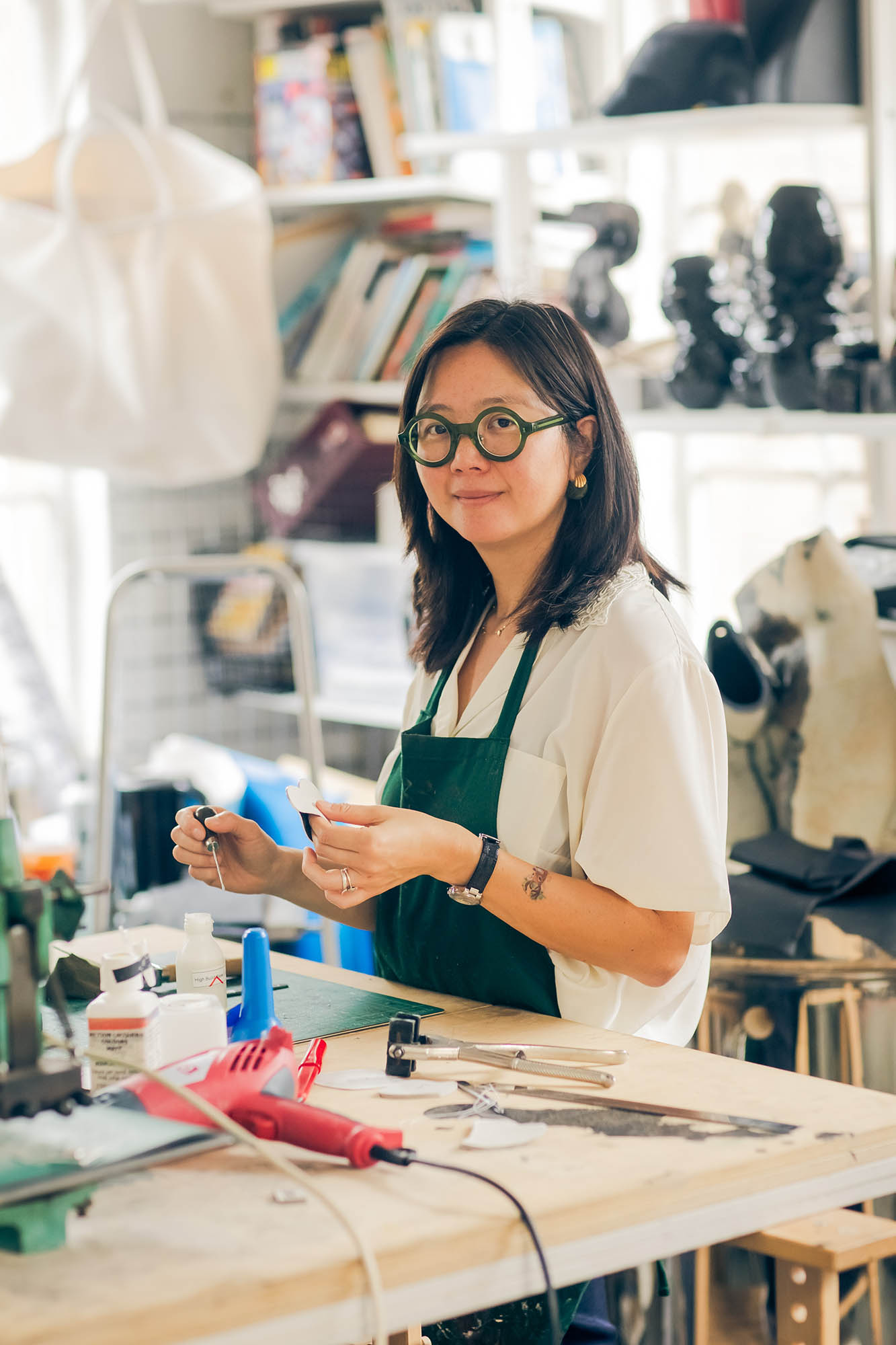
“I was fortunate to have been taught by one of the last remaining former pupils at the school. We would spend two weeks making just one bag.”
Meanwhile, it was the Covid pandemic that pushed the pair to embrace technology as a means of reaching a wider audience. By learning video and audio editing, Deborah compiled a programme of films, workshops and interviews for the Digital Shoemakers Conferences in 2021 and 2022, creating a unique library of interviews with industry heroes including Billy Amberg, Bill Bird and Bakers of Colyton and recent arrivals, Billy Tannery. Says Deborah: “We decided to put these new skills to good use, and made a series of shoe and pattern making training films for our website. It was months of filming and editing, but the six shoe making modules are proving to be a big hit with aspiring shoemakers around the world.”
As part of her successful decade-long leatherwork practice, own-brand designer, Leathersellers’ Foundation QEST scholar and teacher, Candice Lau, runs a variety of leathermaking workshops, including one-day courses covering pattern making and saddle stitching, from her space at London’s Cockpit Studios. The Hong Kong-born artist is also a lecturer at The Hong Kong Polytechnic University, teaching the online leatherwork module on the Masters in Fashion and Textiles course, while her book, The Leathercraft Handbook, a step-by-step guide to leather-craft techniques, is having a second run this year.
Her journey to becoming a maker began when she was working as a graphic designer for a small, London agency. One Christmas, her ‘amazing boss’ gave each member of the team a £200 bonus, which Candice promptly put towards buying a sewing machine. Then, when a colleague’s old flatmate who was working with leather left two rolls of cow’s hide behind, she happily accepted them and began making bags. Looking back, she says: “I didn’t know how to make a pattern. I didn’t know how to stitch and because of doing that bag so badly, it gave me the push to really learn and understand the art of my craft.” From there, she enrolled on a series of short courses, including a pattern-making summer course at the London College of Fashion.
Then, following a magazine interview in 2014, serendipity led her to The Leathersellers by way of a business card that the journalist accidentally left behind. The card belonged to a leather maker who had won the Leathersellers’ Award, so Candice Googled the organisation and saw that applications for a Cockpit Studio space were closing in a week. “I managed to get my application in on time, went for the interview and bagged a spot. After that, I applied for a Leathersellers Queen Elizabeth Scholarship Trust grant and was awarded a scholarship.”
The grant allowed her to travel to Florence and take a three-month leather-making course at the prestigious Scuola del Cuoio, housed in the old dormitories of the Basilica of Santa Croce. “The teaching experience shifted my way of thinking and taught me about the value of handmaking.” As for other course highlights, she adds: “I was fortunate to have been taught by one of the last remaining former pupils at the school. We would spend two weeks making just one bag. At the time I didn’t realise the complexity of certain techniques. I learnt how precise your pattern making needs to be, how much time you need to do really beautiful edging or the fact that the majority of high-end bags are made from backing rather than leather to keep their shape.”
So, what led her to become a teacher? “From the very beginning, I’ve always loved the way learning makes you feel. I also saw a possibility from being a graphic designer to being able to create a business out of making, to be able to live on what I love doing, so from the outset, I enjoyed sharing my knowledge with others.”
Giving her students confidence is all part of this rewarding job. “I want all my students to feel as if they are in their own workshop, not sitting at a desk waiting for me to tell them every single step. I like them to know that by the second or third day, that they are going to own this project. This sense of being able to make their own decisions about how to work is so much more empowering.”
Meanwhile, Candice recently began teaching young adults at schools across London as part of a charitable initiative, The Creative Dimension Trust. Started by ceramics conservator Penny Bendall, the programme funds schools and gives 16-18-year-olds the chance to learn crafts outside of school hours.
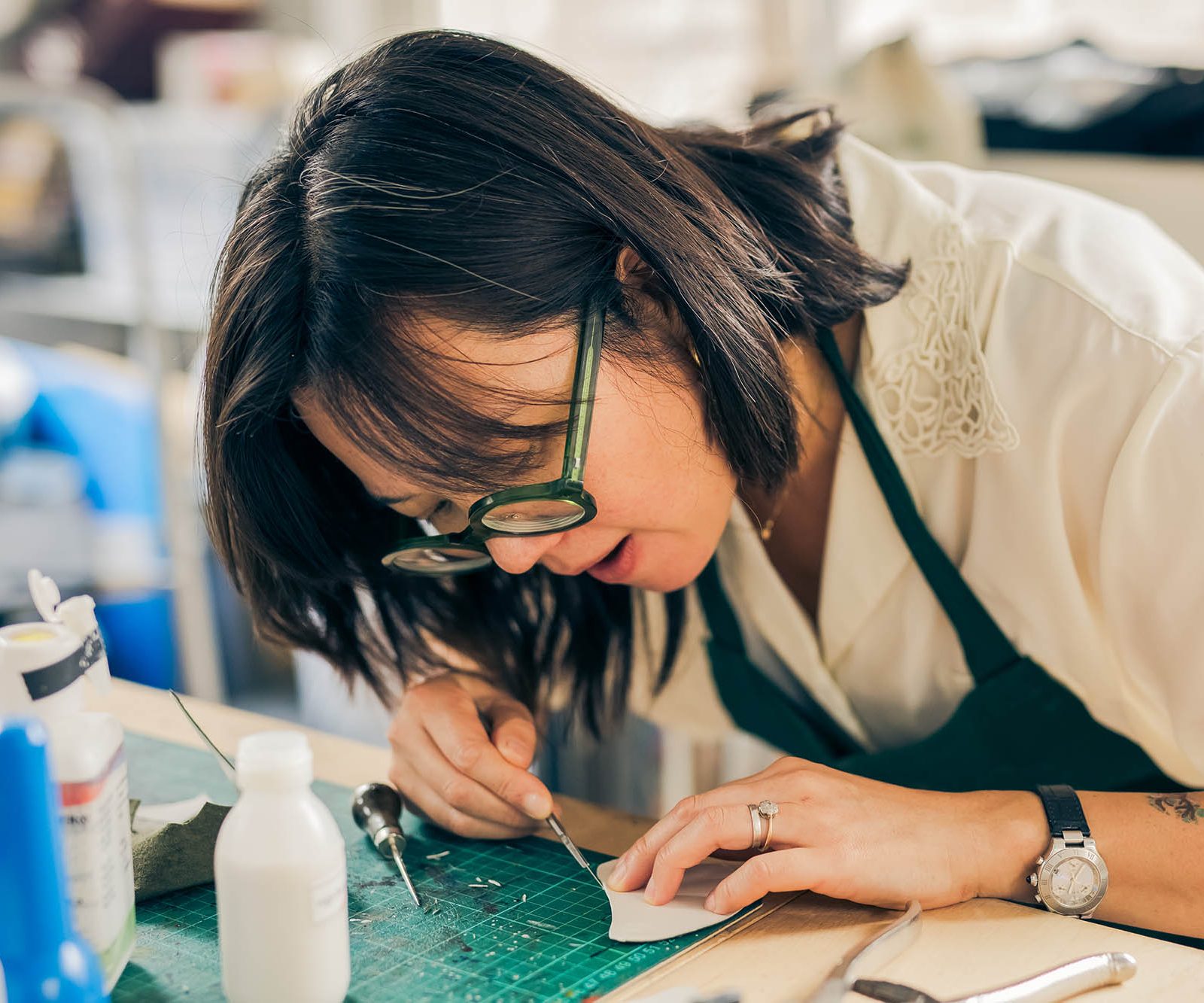
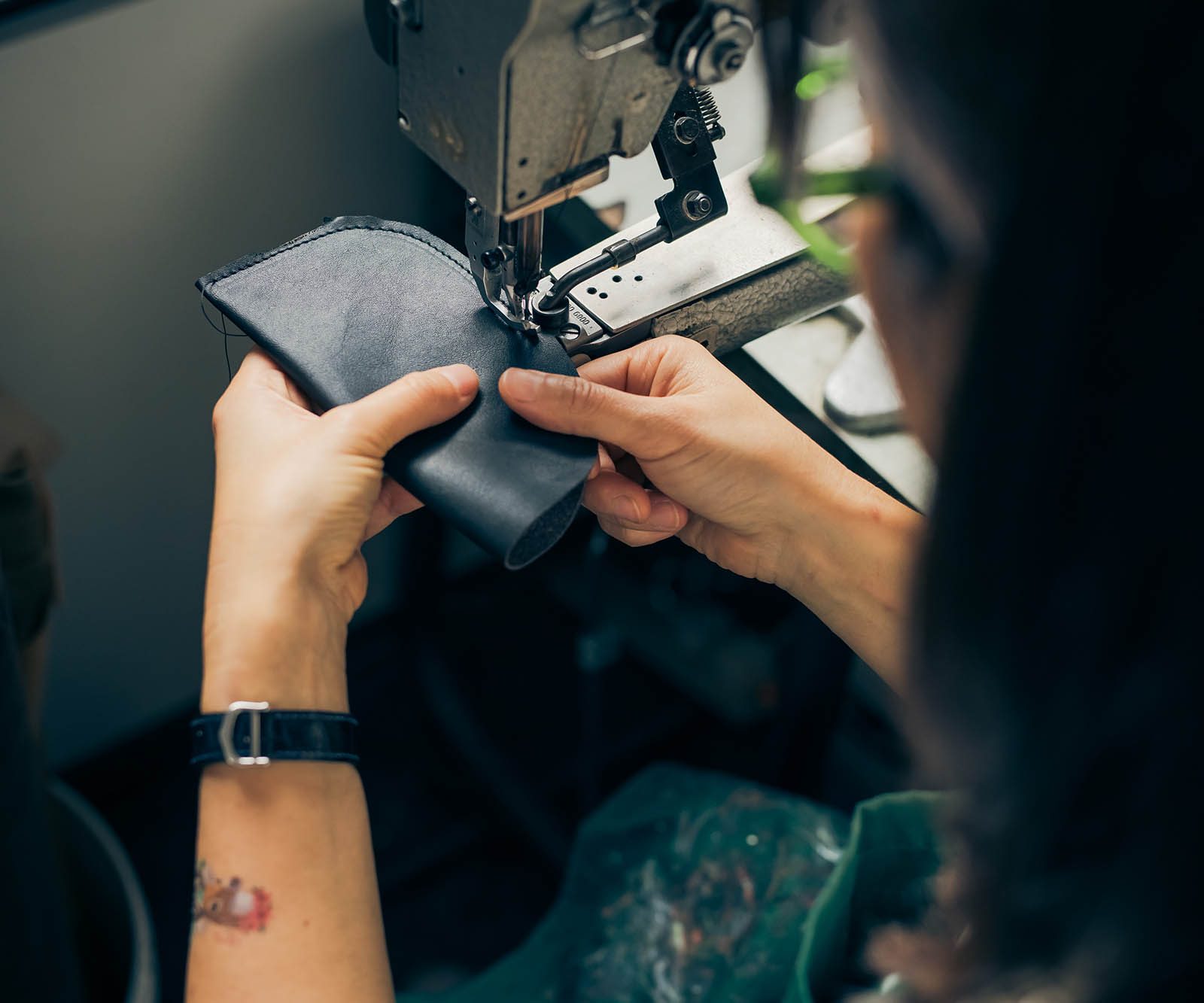
“Teaching this age group can be challenging but there was this one girl who said she wanted to do a saddlery course and open her own business. She was only 16 and didn’t come from a family where she was exposed to the idea of being self-employed but had learned from speaking with others that you can design a life around work that you are passionate about. That whole teaching experience made me so happy.”
And when teaching her ‘Introduction to Leathermaking’ to groups of more mature students which she does as part of another community initiative, Acava, she adapts her techniques quickly to suit any limitations.
“You have to be open-minded about a student’s capabilities. Some might not have the hand strength to be able to hammer as powerfully as others so I encourage them to try another technique. Also, you need to understand how to shift your teaching schedule around to allow them more time to stitch. I might even give more peer-to-peer learning so I teach one person and they teach another, as maybe their way of explaining makes more sense to them than mine.”
It’s clear to see how much keeping leather traditions alive means to Candice and other dedicated teacher-makers like her. “In every single project I do there is an element of handwork that can’t be done on a machine,” she says. “Unless a super, high-tech machine can replicate what my hands are doing, then we will always need skilled and experienced teachers to pass their knowledge on. We need to have more of a breadth of difference in our society – that unique, human touch, that only an artisan teacher can provide.”